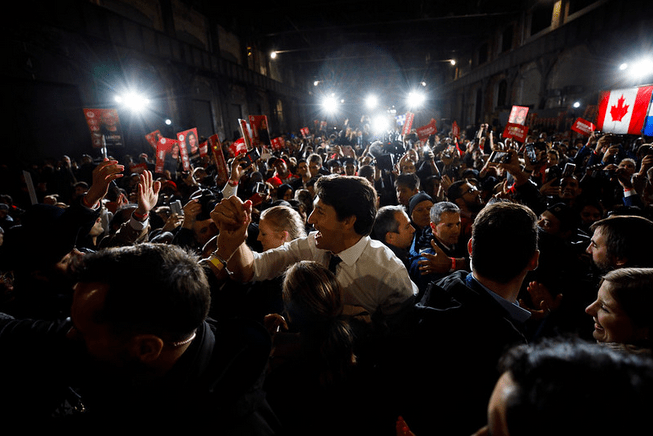Next Steps in a New Political Reality

Adam Scotti
L. Ian MacDonald
Oct. 22, 2019
Monday’s election results have generated a new political environment for every leader who’ll be standing in the House when the lights go on.
Now that the results are in and the Trudeau government has been re-elected with a minority, set aside Nov. 4 as a good candidate for the swearing-in.
For symbolic starters, it will mark four years to the day from the swearing-in of his first, majority Liberal government. For another, it will be two weeks to the day from the election, the normal transition period.
The coming swearing-in is more than a walk up the driveway at Rideau Hall, as was the case with Justin Trudeau’s triumphal arrival in 2015. This time, it really is about hope and hard work, and the measure of a government that will be taken from its first day on the job.
For a prime minister whose first two years in office were a walk in the park, Trudeau will be arriving at Government House as a survivor of scandals such as the SNC-Lavalin affair, and behavioural misfortune such as the blackface party nights of his life before politics.
Trudeau will put the transition period to use re-staffing the Prime Minister’s Office and appointing a new cabinet. Both PMO and cabinet will see early tests of their ability, judgment and nerve.
The first one will be the question of when to recall the House, and what to put in the Speech from the Throne. There is no hurry here, no reason for the House to sit before the traditional Christmas recess, and no fear of noise about that from the opposition parties, which have internal management and leadership issues of their own.
In his cabinet shuffle, Trudeau must find a way to reach out to Western Canada, where the Liberals were shut out completely in Alberta’s 34 seats and Saskatchewan’s 14 ridings, and reduced to only 11 seats in British Columbia from the 17 out of 42 B.C. seats they held before the election. Welcome to western alienation.
To add insult to injury, former justice Minister Jody Wilson-Raybould, having been fired by Trudeau and expelled from the Liberal caucus, won her Vancouver riding as an independent.
If Trudeau wants an influential western presence at the cabinet table, he could do worse than name Ralph Goodale government leader in the Senate, following the painful loss of his Regina seat in the House. Never mind the rule Trudeau brought in about having to apply for a Senate appointment. Someone can fill in the form for Goodale, the strongest and ablest western minister in decades.
In terms of a throne speech, this is where Trudeau and the Liberals will need to pay attention to Jagmeet Singh and the NDP. Though the New Democrats fell short of final poll projections by winning only 24 seats, that’s more than they would have won a month ago, when Singh began his starring role in the campaign. The New Dem deputation will put the Liberals in majority territory, over the 170-seat threshold from the 157 they won on their own.
Thus, Singh is the only partner Trudeau needs. This is called a “workable minority.” The Liberals and NDP have been here before, in the halcyon days of Lester B. Pearson and Tommy Douglas in two minority Liberal governments elected in 1963 and 1965.
Just a few seats short of a majority in the then 265-seat House, Pearson played democracy’s honest broker with Douglas, the NDP’s founding father.
They left us with an impressive parliamentary legacy that included the Canadian flag, universal health care and pensions. And where they had to deal with Québec, they did, on those transferable issues of federalism. Their Québec colleagues of that era were Jean Lesage and Daniel Johnson, two of the great premiers of modern Quebec history. If Yves-François Blanchet wants role models to emulate as leader of the Bloc Québécois, he need look no further than those two, who always stood up for Québec’s interests within a Canadian federal framework.
For Singh, this is an opportunity to play in the majors on issues such as pharmacare, where the NDP and Liberals are on the same page. Welcome to the NHL, Jagmeet.
Where do Andrew Scheer and the Conservatives fit in this scenario of a minority House? The answer is “That depends.”
It depends largely on Scheer’s leadership, and whether the party is satisfied with both his performance and his prospects. They are looking at a leadership review next year.
On performance, the Conservatives increased their presence in the House by more than two dozen members, to 121 seats. And they won the popular vote at 34.4 per cent compared with 33 per cent for the Liberals. But the pop-vote share has no constitutional standing in forming a government, and the Liberal vote was efficient where it had to be—in the Greater Toronto Area, which they swept.
Scheer spoke in his concession speech of “coming close but falling just short.” He declared “our party is strong and on the march.” He went on: “Tonight, Canadians have put Mr. Trudeau on notice. When your government fails, we will fight you and we will win.”
That remains to be seen, as does the climate of the new House. The leaders’ speeches all struck a partisan tone, as if they were still on the campaign trail.
Apparently, no one told them that election night is a moment for healing in the land.
L. Ian MacDonald is editor and publisher of Policy Magazine.
